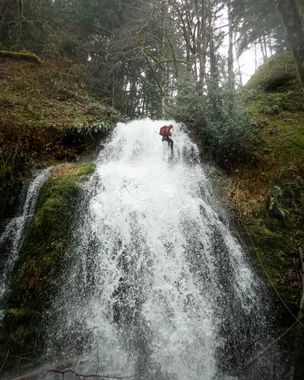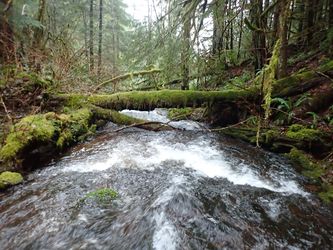Lousignont Creek
| Rating: | |||||||||||||||||||||||||||||||
|---|---|---|---|---|---|---|---|---|---|---|---|---|---|---|---|---|---|---|---|---|---|---|---|---|---|---|---|---|---|---|---|
| | Raps:2+, max ↨100ft
Red Tape:No permit required Shuttle:None Vehicle:Passenger | ||||||||||||||||||||||||||||||
| Location: | |||||||||||||||||||||||||||||||
| Condition Reports: | 2 Jan 2021
"Fun short creek. Good flows made it fun without it would be rather boring. There needs to be a flood event to clear out the bottom of the 2nd drop. Fu |
||||||||||||||||||||||||||||||
| Best season: | Dec-Feb
|
||||||||||||||||||||||||||||||
| Regions: | |||||||||||||||||||||||||||||||
Introduction[edit]
Lousignont will never be one of the "big dogs" of canyoning in the Pacific Northwest, but it's a great short outing in January when you're starting to get jittery and need your rappel fix. A great one to do on a rainy day when everything else is running at flood stage. Super short and can be run in a couple hours even in the rain. Don't bother later in spring, summer or fall. It's not worth your time. You've been warned.
- Watershed: 0.9mi^2.
Approach[edit]
From the parking area, head down the slope to the south until you intercept an overgrown logging grade (maybe 100ft away). Head upstream a short distance, then drop down to meet the creek. Head downstream wherever is easiest to the top of R1. There's some nice bedrock just above the falls. Current can be pushy in flood conditions.
Descent[edit]
- R1: 100ft from a tree DCR. A doubled 200ft rope will just make it to the bottom from the anchor.
Head downstream and practice your parkour skills getting over, under and through a few log jams. Use caution approaching R2.
- R2: 50ft from a tree DCL. An anchor further back will better position you in the flow. In 2021 there was a lot of debris at the bottom of the falls.
Exit[edit]
Looking downstream from R2, note the mossy ridge immediately DCL. This is your exit ramp. Follow it all the way back up to the road (~300ft elevation gain). Keep going until you run into the road and walk back to your cars. You will cross the old logging grade on the way.
Red tape[edit]
None.
Beta sites[edit]
Trip reports and media[edit]
Background[edit]
First descent was in January 2021 by Kevin Clark, Wade Hewitt, Ashley Driscoll, and Wim Aarts.
- Some history on the name Lousignont.

